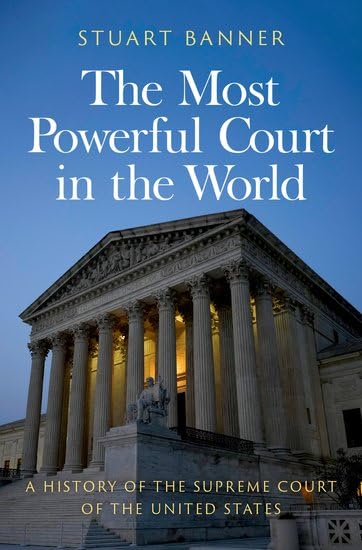The Most Powerful Court in the World: A History of the Supreme Court of the United States
- By Stuart Banner
- Oxford University Press
- 672 pp.
- Reviewed by Jennifer Bort Yacovissi
- December 19, 2024
As it turns out, our times are precedented.

Here’s just one fascinating tidbit provided by Stuart Banner in his latest book, which came out the day before the November 5th presidential election: The words “Equal Justice Under Law” on the west façade of the Supreme Court building was not already a quote when it was chiseled into the stone in the 1930s. Rather, it “was suggested by the architects because it fit the space and sounded right.” (Presumably, “Try Your Luck” or “It Depends” wouldn’t have carried the same gravitas.)
There are insights great and small throughout The Most Powerful Court in the World, all of which help us understand how so much of what we think we know about the Supreme Court is fuzzy at best and often misconstrued. By giving us a thorough history of the Court, Banner wants us to grasp that our contemporary view of it is skewed by our limited sightline. What he delivers is an accessible, engrossing, behind-the-scenes chronology of everything that has gone into the making of the Court and its decisions.
His introduction states, “This book has no heroes or villains. Instead of judging the Court, I try to help the reader see the cases through the justices’ eyes.” His point is that we tend to evaluate the decisions of 150 years ago based on whether they correctly anticipated our modern sensibilities.
(Still, it’s hard to find a good-faith legal argument in, for example, the account of United States v. Cruikshank, which concerned “the 1873 Colfax massacre, the worst incident of racial violence during Reconstruction, in which a mob of white men in Grant Parish, Louisiana, murdered approximately a hundred black people…in order to seize control of the local government.” None of the perpetrators were even charged with murder, but the various charges on which they’d been convicted were dismissed by the Court, and they all went free.)
From the earliest days, appointments to the Court were nakedly political. “If there is anything about the Court that has remained the same since the 1790s,” writes Banner, “this is it.” Most candidates came from elected or other political offices, and it was understood by all concerned that the president would select those who could be depended upon to rule in the prevailing party’s interests.
Early on, the Marshall Court heavily favored Federalist positions, while the subsequent Taney Court swung hard in support of states’ rights. The justices of the late 19th century’s “Lochner era” were solid big-business advocates averse to regulation. LBJ manufactured a vacancy in order to appoint Thurgood Marshall. And no president was more openly political in trying to get his policies through than FDR, who was able to appoint seven justices in four years, and thus had no need to expand and pack the Court as he’d threatened.
There was always plenty of political maneuvering surrounding the timing of cases and the possibility of vacancies as presidential elections drew near. After Lincoln’s assassination, Congress shrunk the size of the Court from 10 to seven justices (to be implemented through attrition) to forestall any Andrew Johnson appointments. Once Johnson was safely gone, Congress set the number at its current nine. Changes to any element of the Court system, especially expansion, can only take place when a single party holds all the reins of power. (So be forewarned.)
In addition to political considerations, because they rode circuits for part of the year, early justices were selected with a strong focus on regional representation. Hence, until the Civil War, there was always a solid coalition of slave-state jurists. Later, selection criteria shifted to include religious diversity — as when the first Jewish and Catholic justices were seated — and later still, racial diversity. Naturally, gender diversity arrived last.
Originally, the Court was required to accept and decide every case brought before it. Former president and long-serving chief justice William Howard Taft arguably had the greatest impact on the Court’s becoming what it is today by engineering its ability to select the cases it would hear. In the ensuing years, the Court has heard and decided fewer and fewer cases. “By 2009,” writes Banner, “the Court heard fewer than 1% of the cases presented to it…and in the 2021 term, the Court decided only sixty-eight cases, or less than half of what had once been the norm.” (The author alludes to the accompanying expansion of the “shadow docket,” so called because of its lack of transparency, but does not address it directly.)
True to his stated objectives, Banner rarely betrays an opinion about the Court’s decisions or the process by which justices are selected. For example, he refrains from characterizing the Merrick Garland/Amy Coney Barrett appointment dichotomy as “rank hypocrisy” or “cynicism of the highest order,” instead leaving the reader to fill in those descriptors for herself. And Clarence Thomas’ extensively documented conflicts of interest without recusal merit hardly a mention.
As Banner illustrates, justices throughout the Court’s history have rendered rulings based on their own beliefs and desired outcomes, accompanied by a larger or smaller fig leaf of legal reasoning (see especially chapter seven, “The Jim Crow Court”). Their success depends entirely on whether their preferred outcomes comport with those of the current majority. In every era, explains Banner:
“Each side was certain it was being true to the Constitution and that its opponents were using the Constitution illegitimately to advance their political goals.”
His overall point is twofold: First, there has always been a hue and cry from the losing faction over closely watched Supreme Court decisions; and second, those headline cases comprise a small percentage of the decisions handed down — even in this era of fewer decisions overall — and lesser-known cases often don’t break along expected partisan lines.
Still, the current Court’s opinions are becoming ever more notorious. Its most egregious to date — that of conferring immunity on a president for nearly any alleged “official” actions and forbidding the consideration of intent in establishing the legality or illegality of an act — occurred too recently to be included here. Yet the decision closely echoes Dred Scott, in which the Court, in what was seen even by supporters at the time as an unseemly power grab, went out of its way to answer a much broader question than the one presented to it, with far-reaching implications.
I wonder if Banner would concede that for the Supreme Court to decide the U.S. president is above the law — despite precedent to the contrary and 248 years of things working just fine without such a ruling — is truly beyond the pale. Or perhaps he sees it as simply another instance, as with Brown and Roe, of the Court deciding to change prevailing law and that, as ever, the pendulum will swing back again.
Perhaps it will, though many of us won’t live long enough to see it. Because now that we’re on the other side of the 2024 election, chances are very good that the 45th and 47th president of the United States will eventually have five young, handpicked justices who will sit on the Supreme Court for decades. We may soon be welcoming Justice Aileen Cannon — with gratitude for services loyally rendered — to this most powerful court in the world, ready to join her right-wing colleagues in exercising raw power to whatever ends they and their favorite unconstrained commander-in-chief see fit.
Jennifer Bort Yacovissi’s debut novel, Up the Hill to Home, tells the story of four generations of a family in Washington, DC, from the Civil War to the Great Depression. Her short fiction has appeared in Gargoyle and Pen-in-Hand. Jenny reviews regularly for the Independent and serves on its board of directors as president. She has served as chair or program director of the Washington Writers Conference since 2017, and for several years was president of the Annapolis chapter of the Maryland Writers’ Association. Stop by Jenny’s website for a collection of her reviews and columns, and follow her on Bluesky at @jbywrites.bsky.social.

